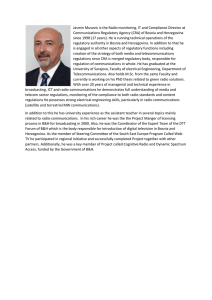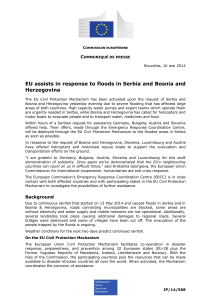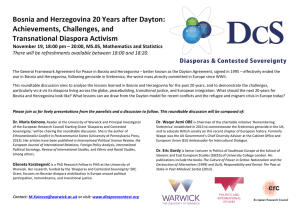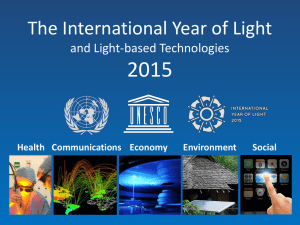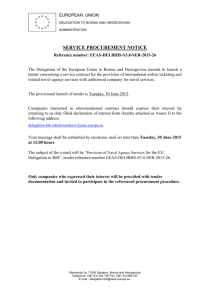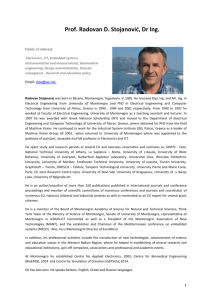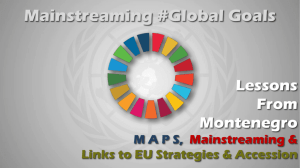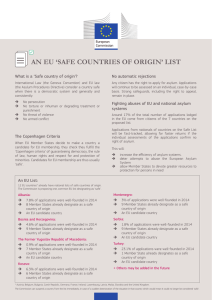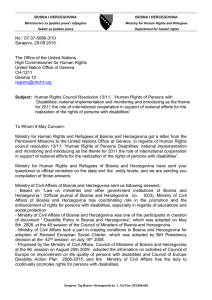First leaflet
advertisement
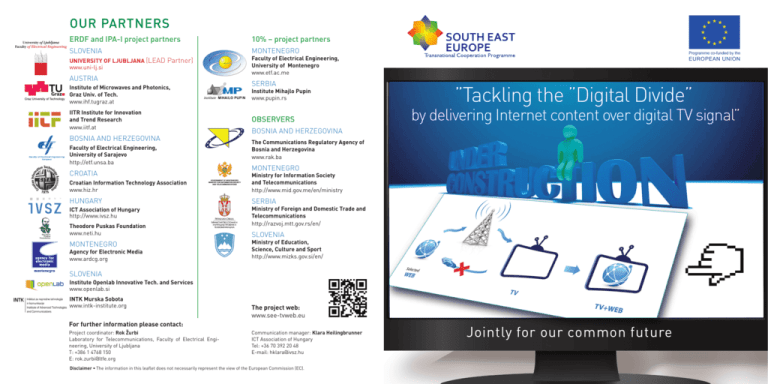
OUR PARTNERS ERDF and IPA-I project partners Slovenia University of Ljubljana (LEAD www.uni-lj.si 10% – project partners Montenegro Partner) Austria Faculty of Electrical Engineering, University of Montenegro www.etf.ac.me Serbia Institute of Microwaves and Photonics, Graz Univ. of Tech. www.ihf.tugraz.at Institute Mihajlo Pupin www.pupin.rs IITR Institute for Innovation and Trend Research www.iitf.at OBSERVERS Bosnia and Herzegovina Faculty of Electrical Engineering, University of Sarajevo http://etf.unsa.ba Croatia Croatian Information Technology Association www.hiz.hr HUNGARY ICT Association of Hungary http://www.ivsz.hu Theodore Puskas Foundation www.neti.hu Montenegro Agency for Electronic Media www.ardcg.org ”Tackling the ”Digital Divide” by delivering Internet content over digital TV signal” Bosnia and Herzegovina The Communications Regulatory Agency of Bosnia and Herzegovina www.rak.ba Montenegro Ministry for Information Society and Telecommunications http://www.mid.gov.me/en/ministry Serbia Ministry of Foreign and Domestic Trade and Telecommunications http://razvoj.mtt.gov.rs/en/ Slovenia Ministry of Education, Science, Culture and Sport http://www.mizks.gov.si/en/ Slovenia Institute Openlab Innovative Tech. and Services www.openlab.si INTK Murska Sobota www.intk-institute.org The project web: www.see-tvweb.eu For further information please contact: Project coordinator: Rok Žurbi Laboratory for Telecommunications, Faculty of Electrical Engineering, University of Ljubljana T: +386 1 4768 150 E: rok.zurbi@ltfe.org Communication manager: Klara Heilingbrunner ICT Association of Hungary Tel: +36 70 392 20 48 E-mail: hklara@ivsz.hu Disclaimer • The information in this leaflet does not necessarily represent the view of the European Commission (EC). Jointly for our common future The aim of the TV-WEB project is to deliver Internet content to those who do not usually use Internet services and who have no broadband connection. The idea is to use the free digital terrestrial television (DTT) broadcasting frequency spectrum capacities for transmitting selected Internet content (such as news, e-services etc.) and ensure a sort of Internet experience via TV devices to certain less advantaged segments of the population, or those in rural areas without broadband access. The concept of the project differs from the services provided by technologies such as connected and Smart TV where the Internet experience is ensured by connecting the TV to the Internet. Instead, the SEE TV-WEB project foresees delivery of Internet content to the homes solely using the DTT spectrum. B e nefi c i ari es The SEE TV-WEB project aims to foster accessibility and availability of Internet content – at least providing a minimal internet experience – to vulnerable groups such as the elderly, economically weak and all those who have no access to internet services due to lack of access (rural) or limited computer/internet literacy. In the long term, the project will represent a very important contribution towards solving the issues of Digital Divide and social inclusion and thus will contribute to the creation of a region of equal opportunities. Jointly for our common future Activities The TV-WEB project will include technical, content related, regulatory and economical aspects, and result in a fully functional pilot system able to deliver Internet content over the DVB-T/T2 networks. More specifically, the following activities are foreseen addressing the key issues: Background research activities Promoting new solution and services to the stakeholders and pilot action •survey of the demographic situation in the respective partner countries in the field of broadband penetration and the use of personal computers •awareness rising and promotion activities aimed at stakeholders in order to encourage the adoption of new solutions including content and services opportunities •technical study determining potential solutions as an answer to the identified situation and solutions that are most appropriate in the various national contexts •development of the pilot solution, providing the selected internet content over DTT in partner countries (for a limited period during project duration) •development of the necessary legal and economic framework for the proposed solution(s) •end-to-end network adaptation proposal and implementation of the pilot solution for increasing accessibility in rural areas is foreseen. Studies and guides •elaboration of business case model and guidelines for its implementation to enable decision-makers to make choices about the proposed solution Content and services of the new solution •analyse on the content to be offered to the viewers and develop it for promotional activities •analysis of user behaviour/experience and specific needs in rural areas, also targeting the elderly people The SEE TV-WEB project is co-funded by the European Commission.
